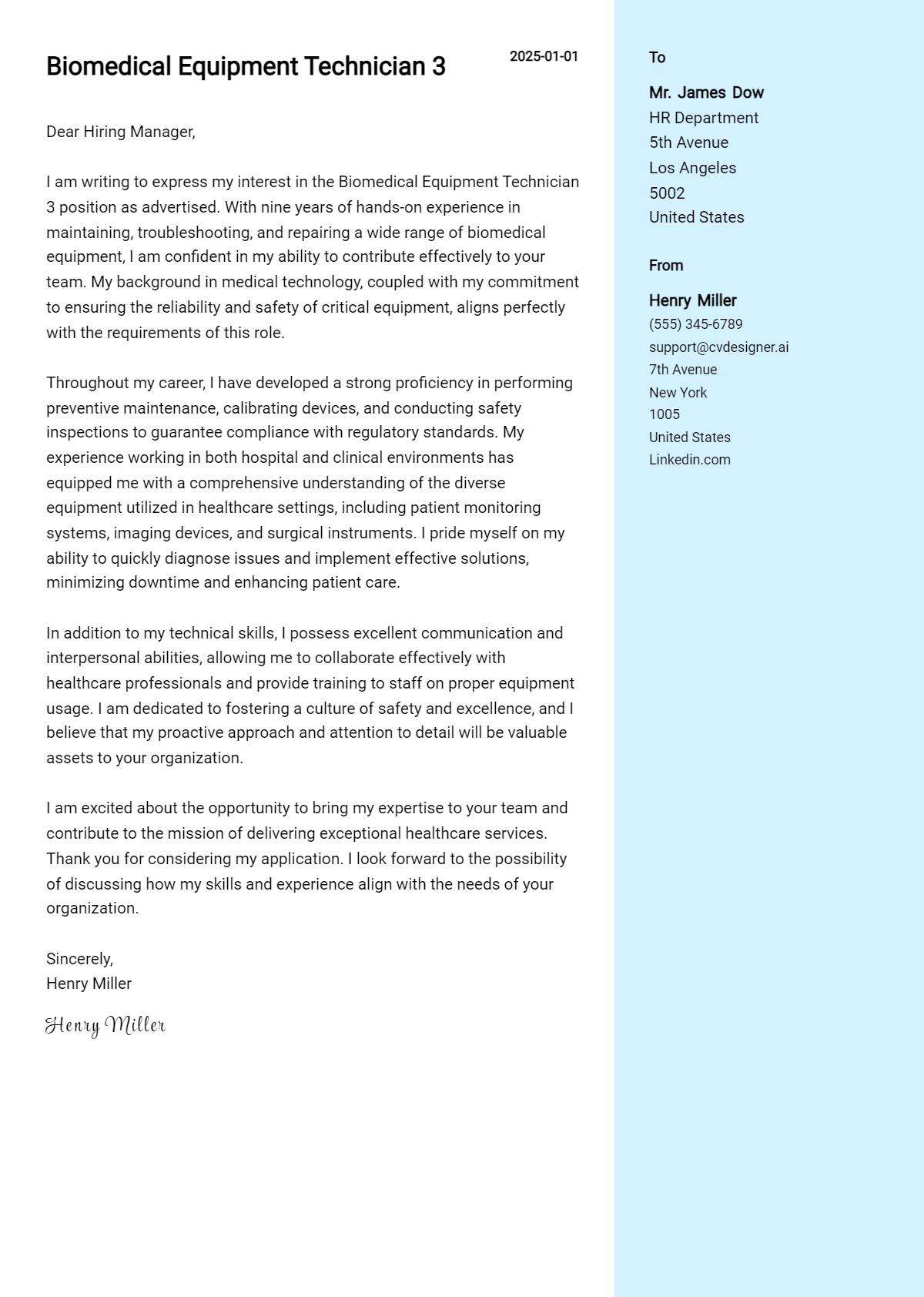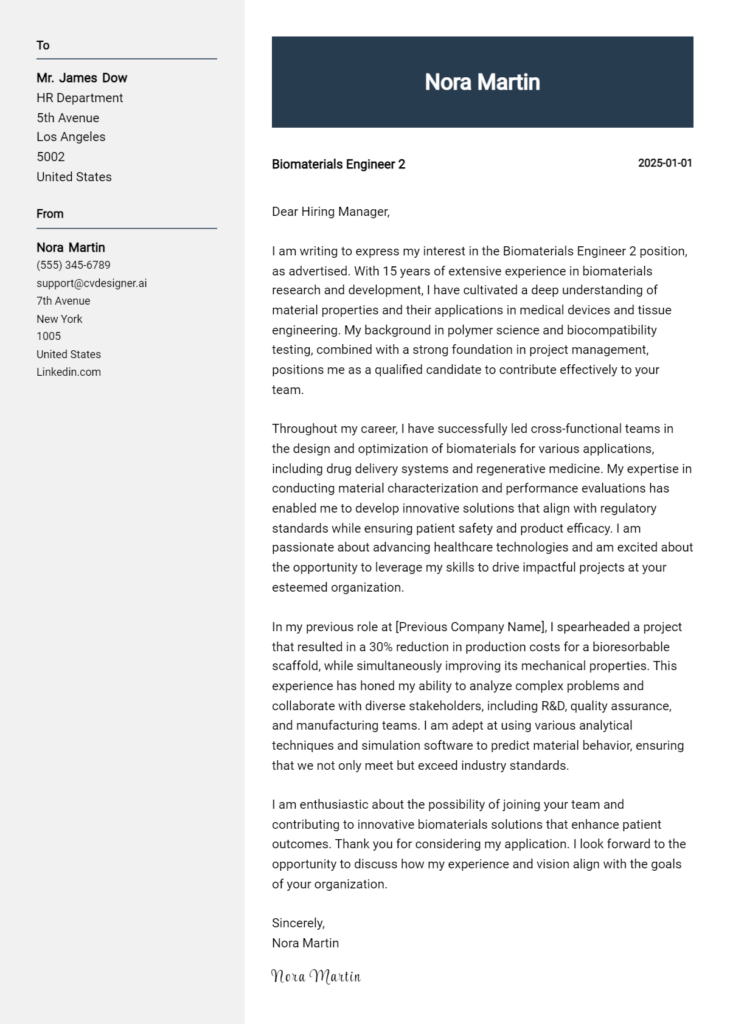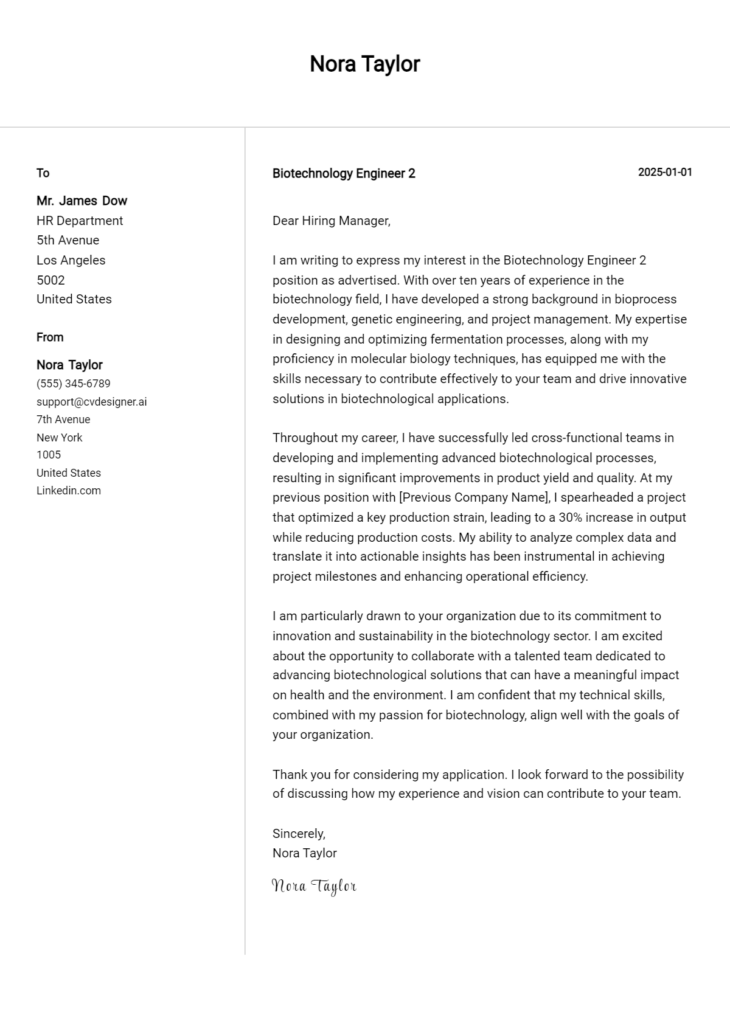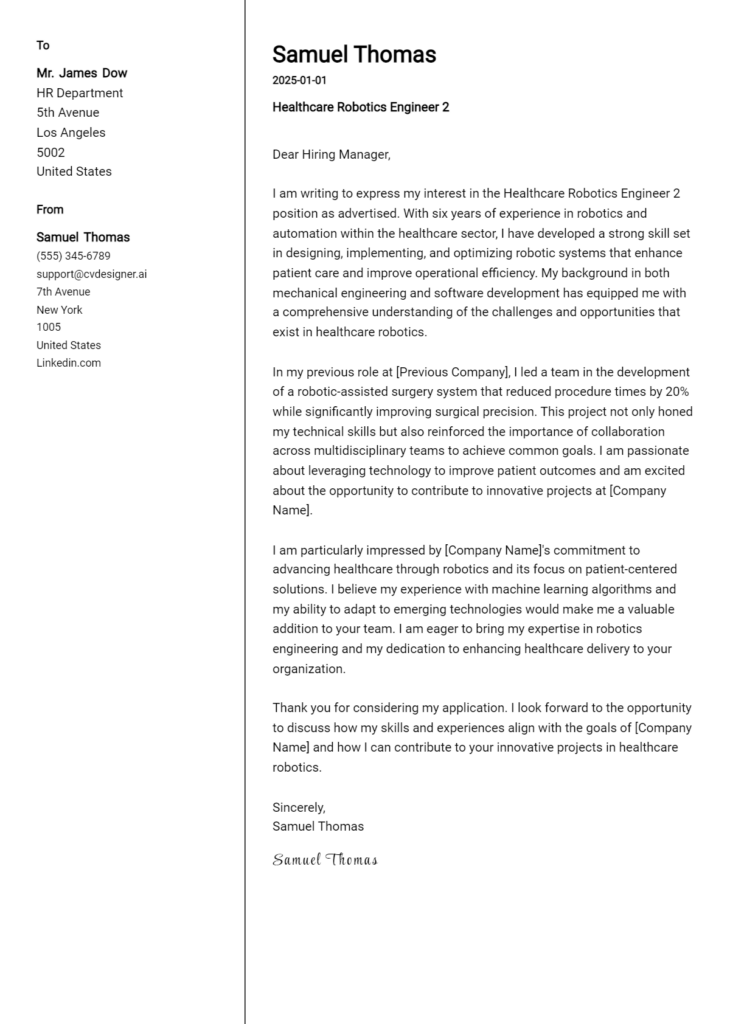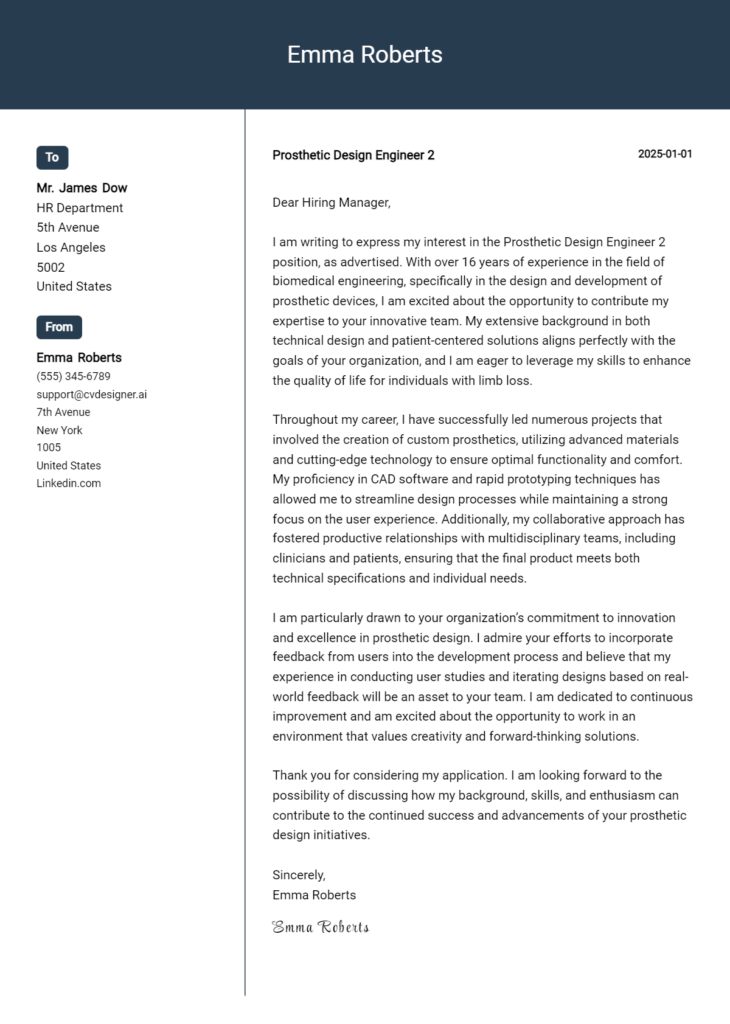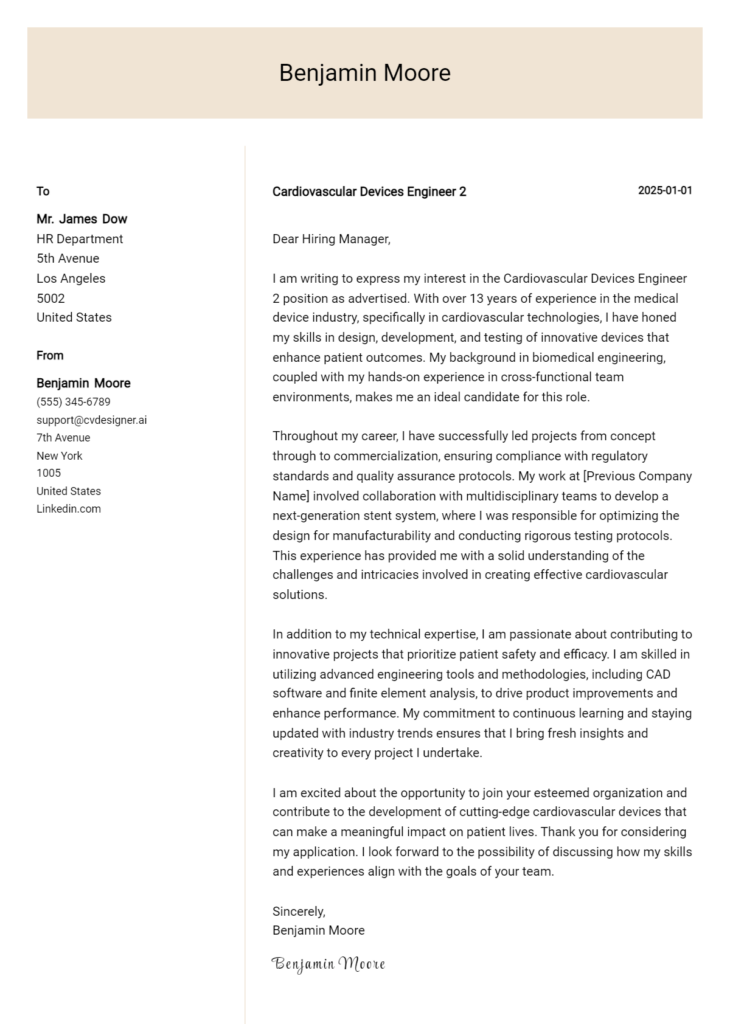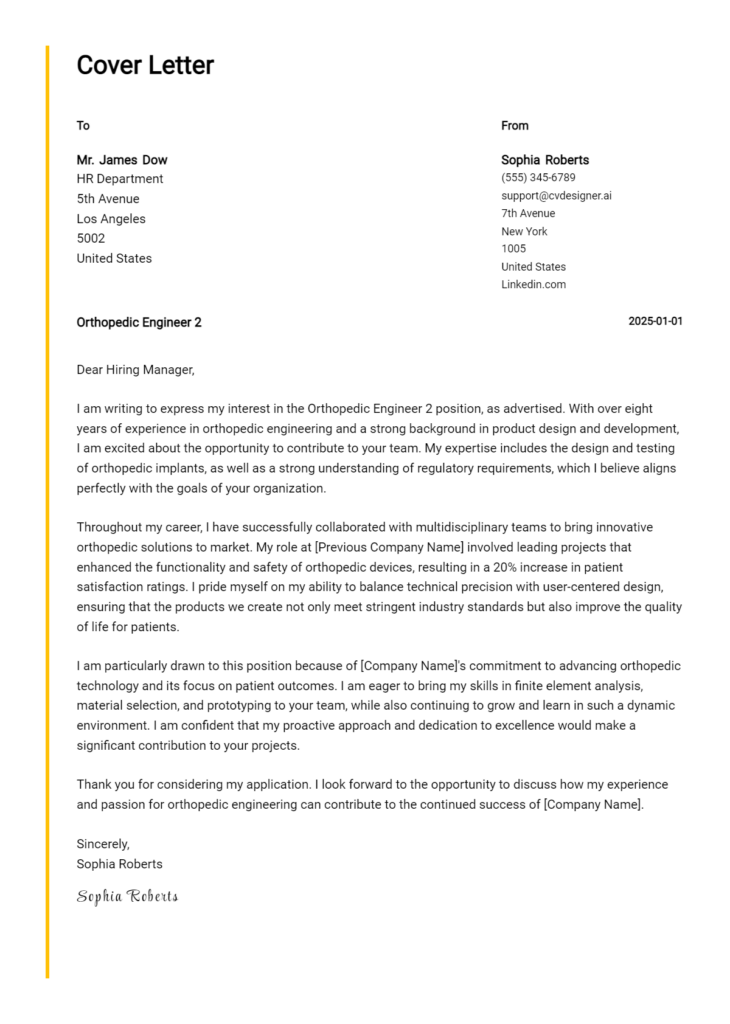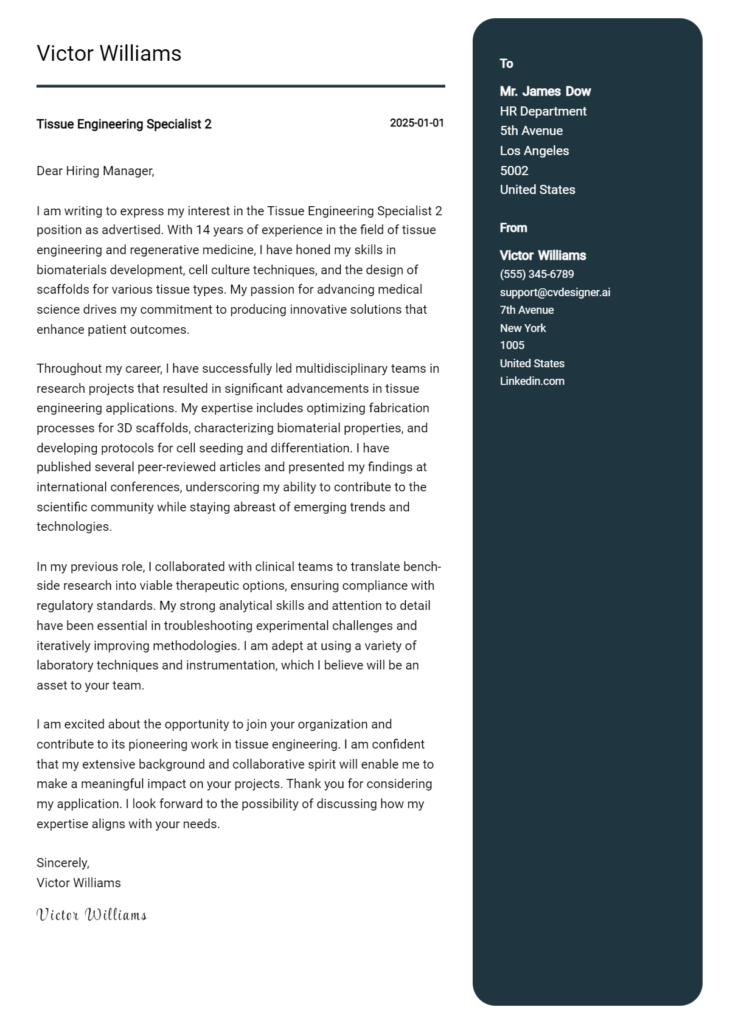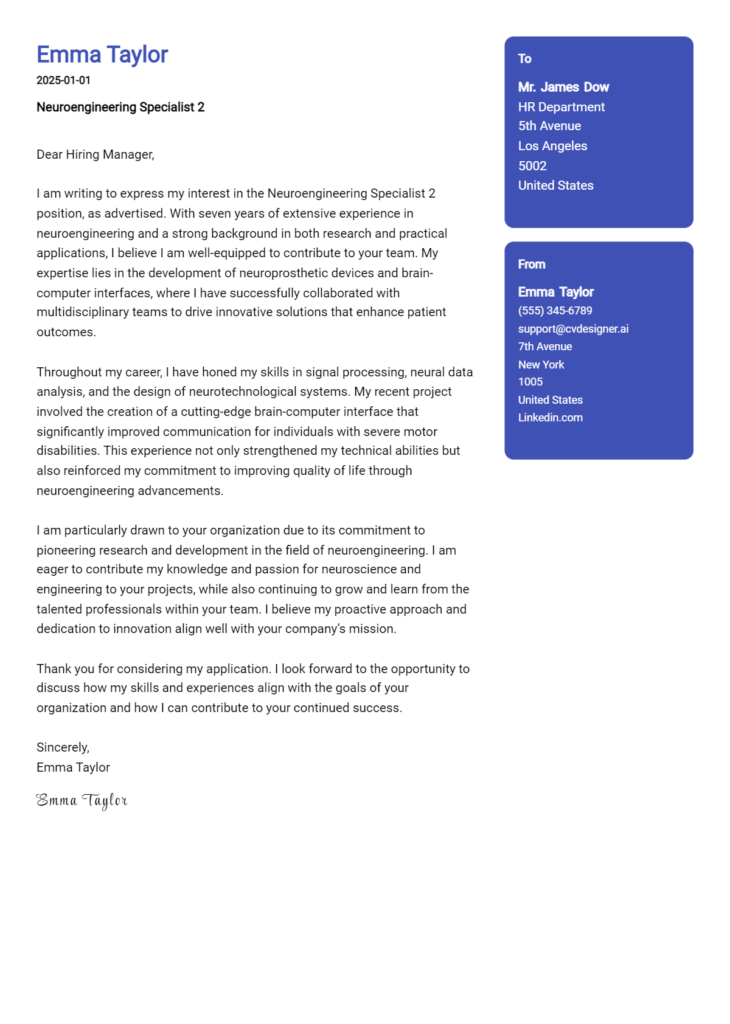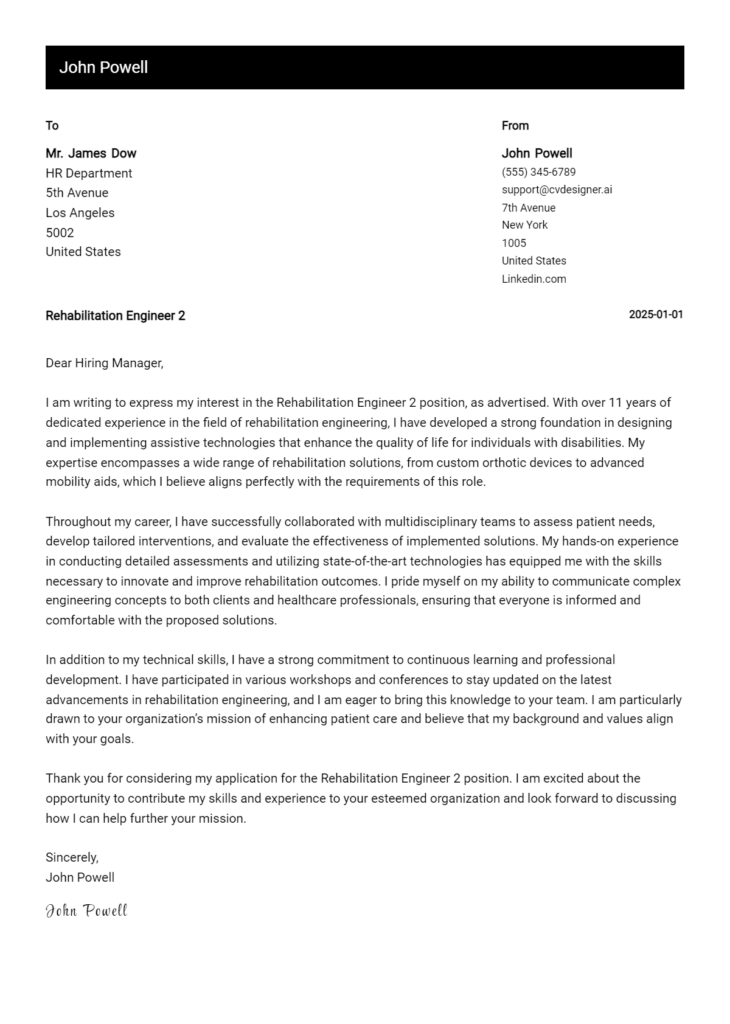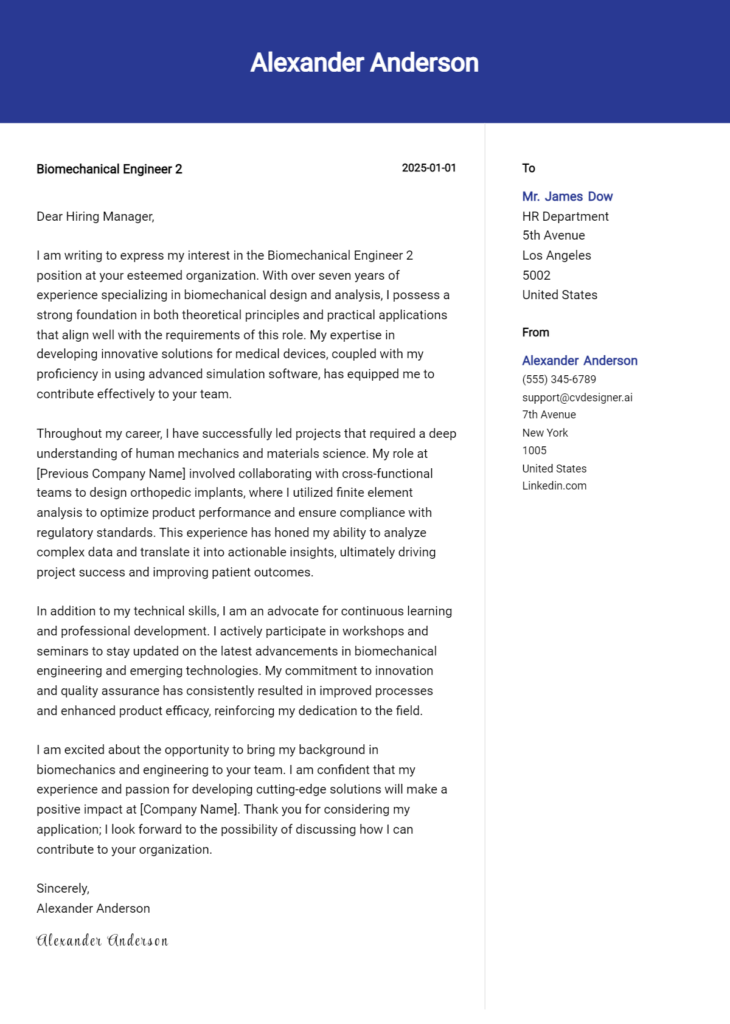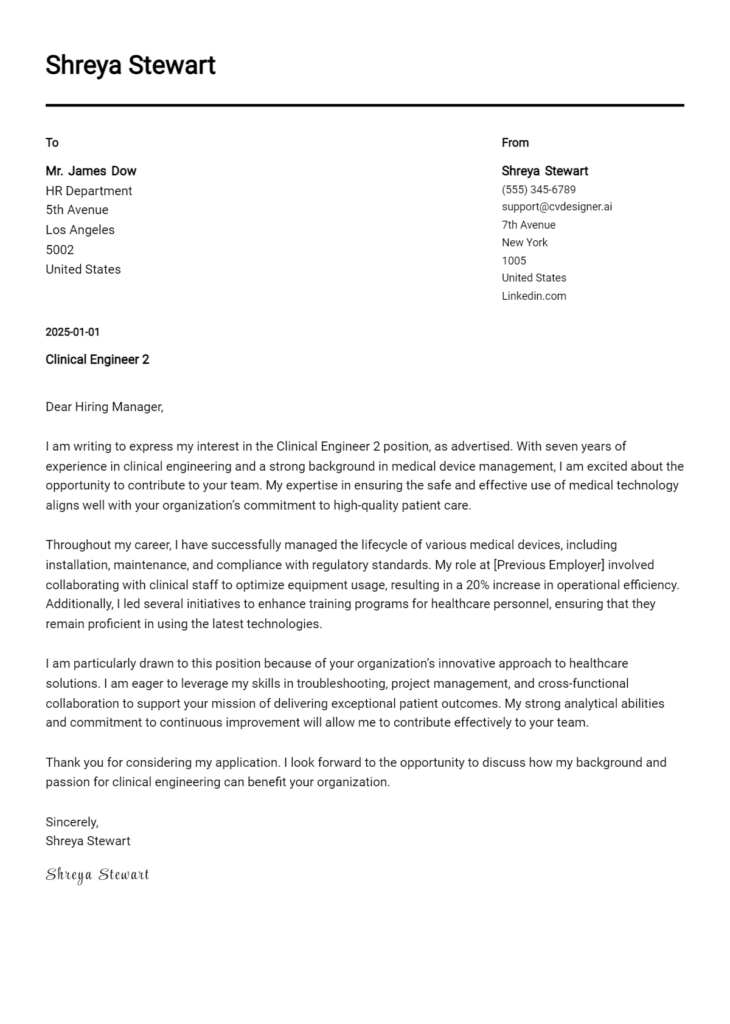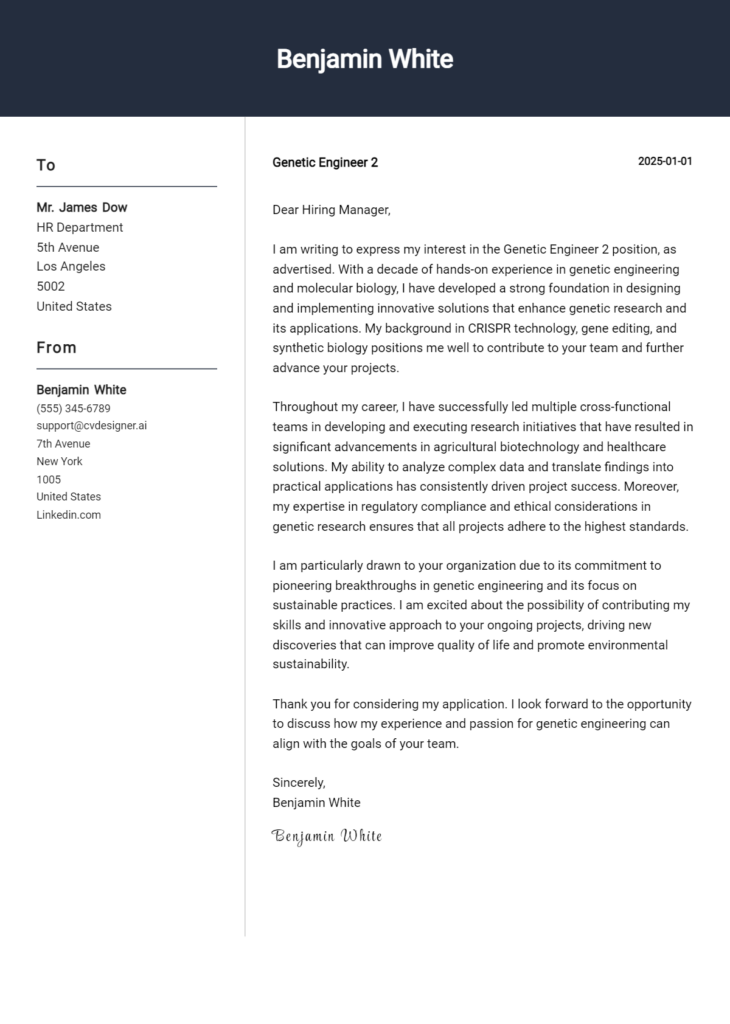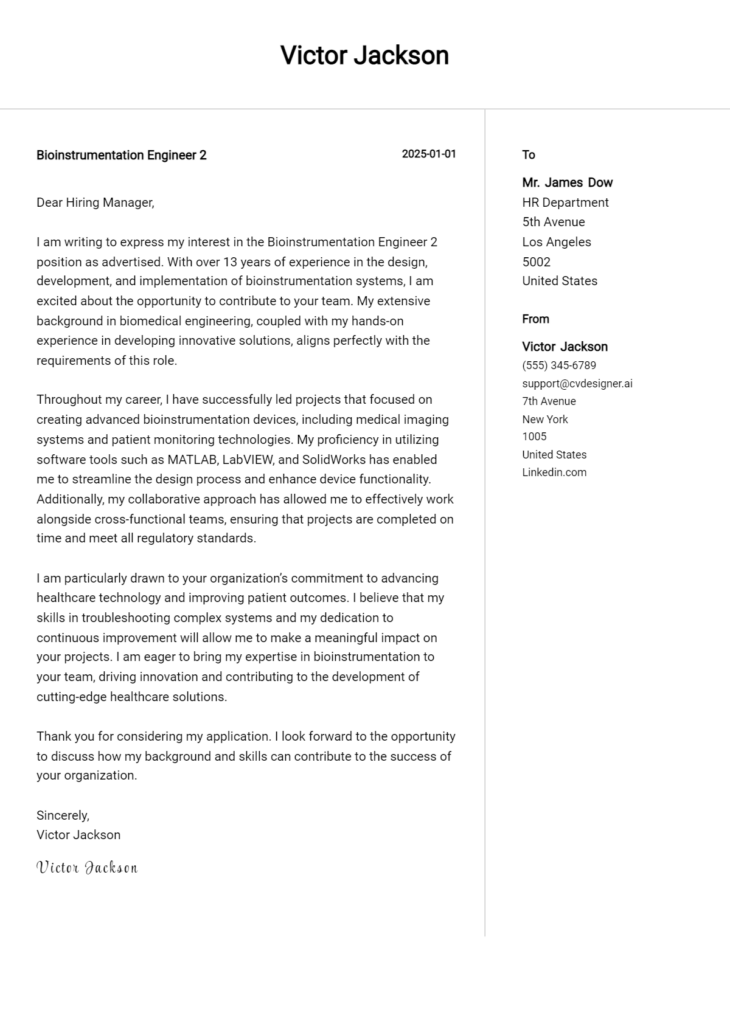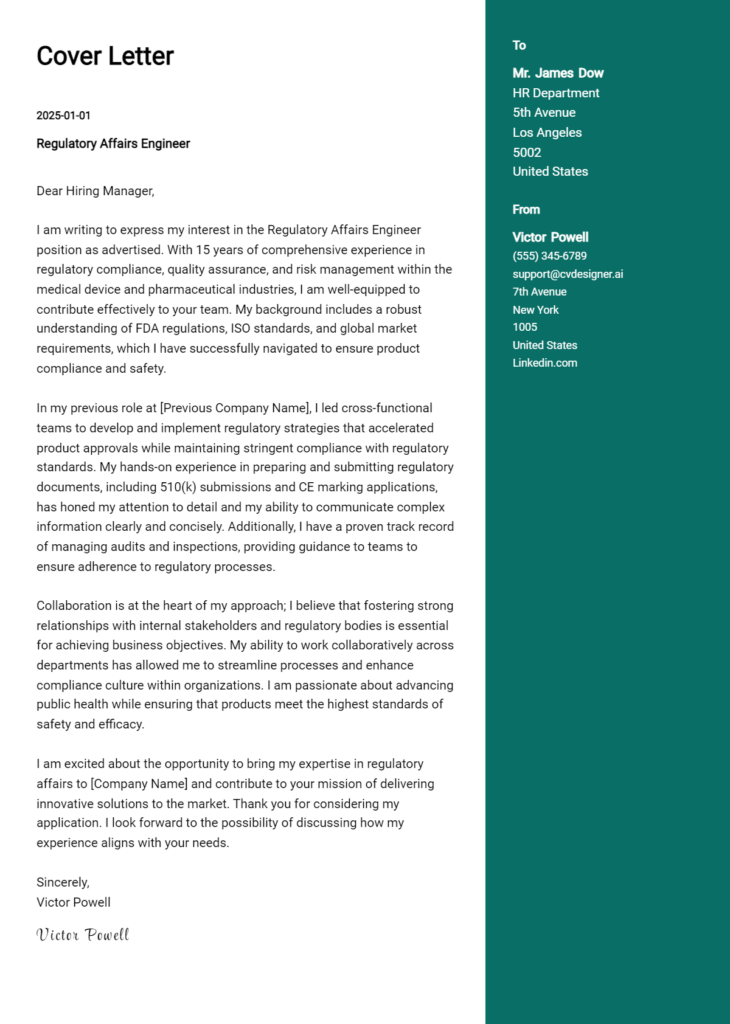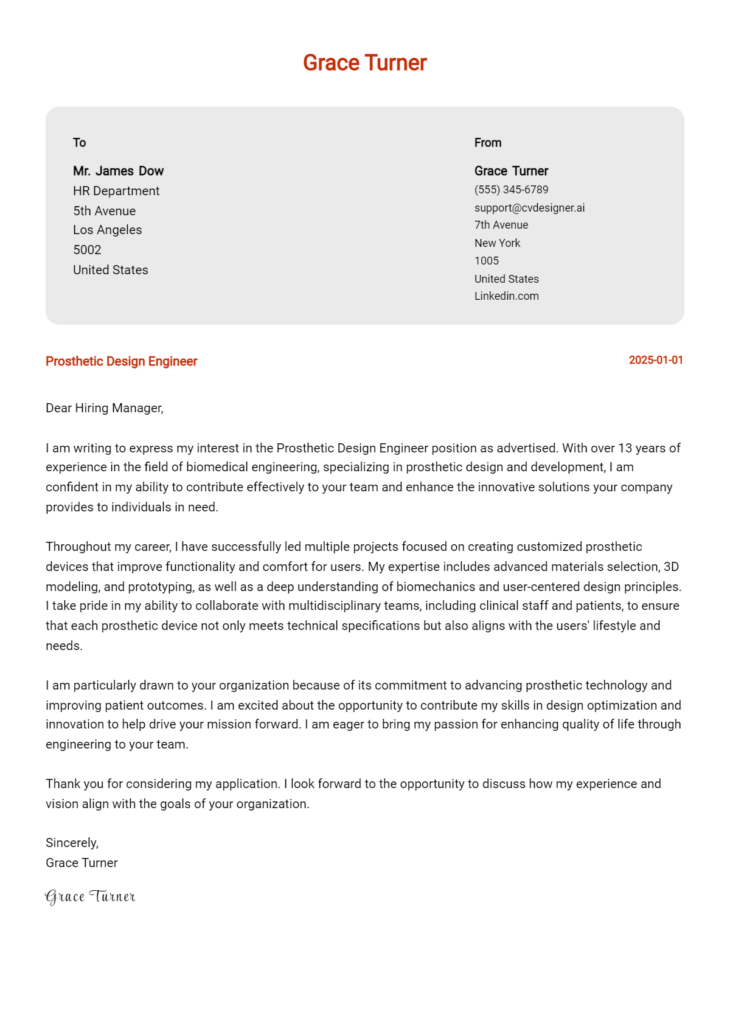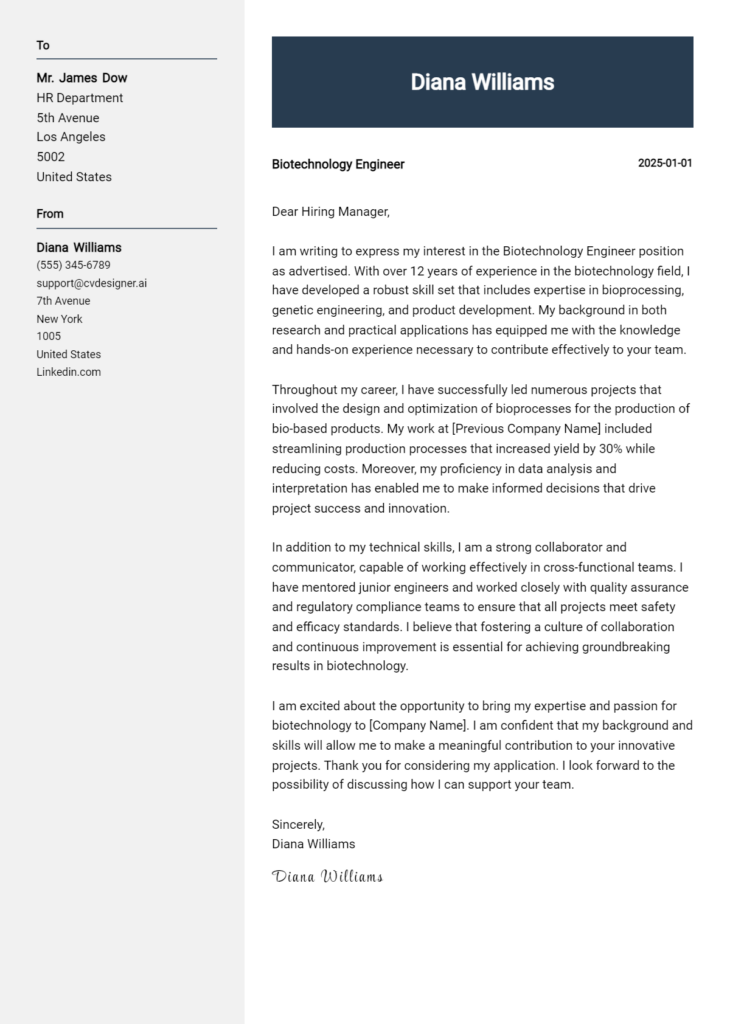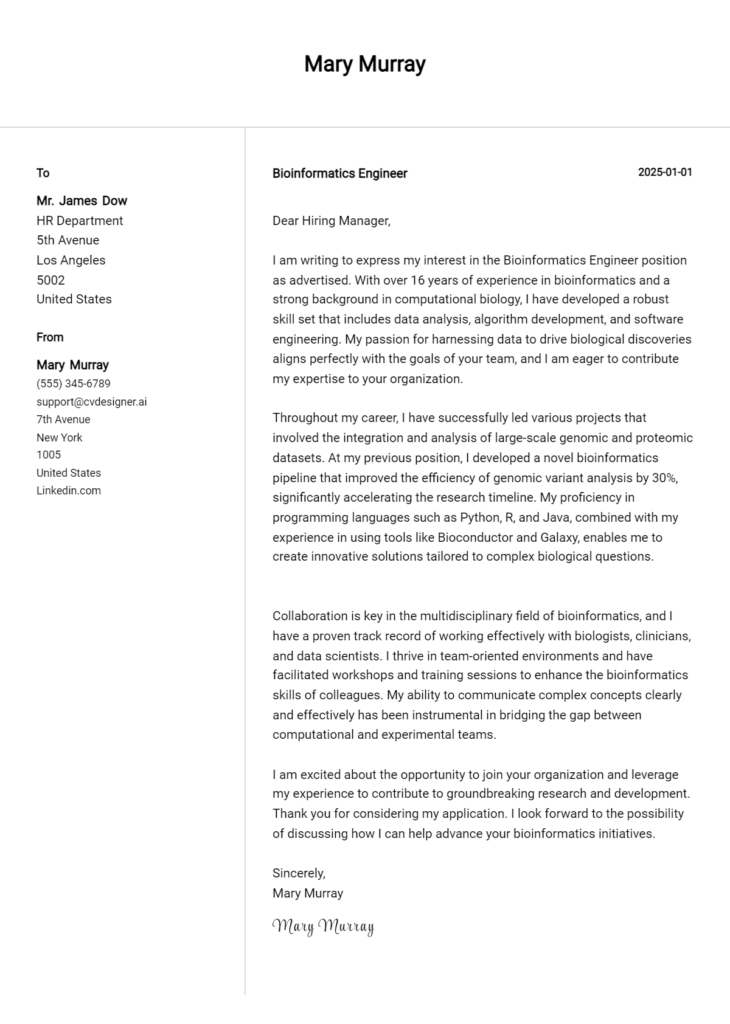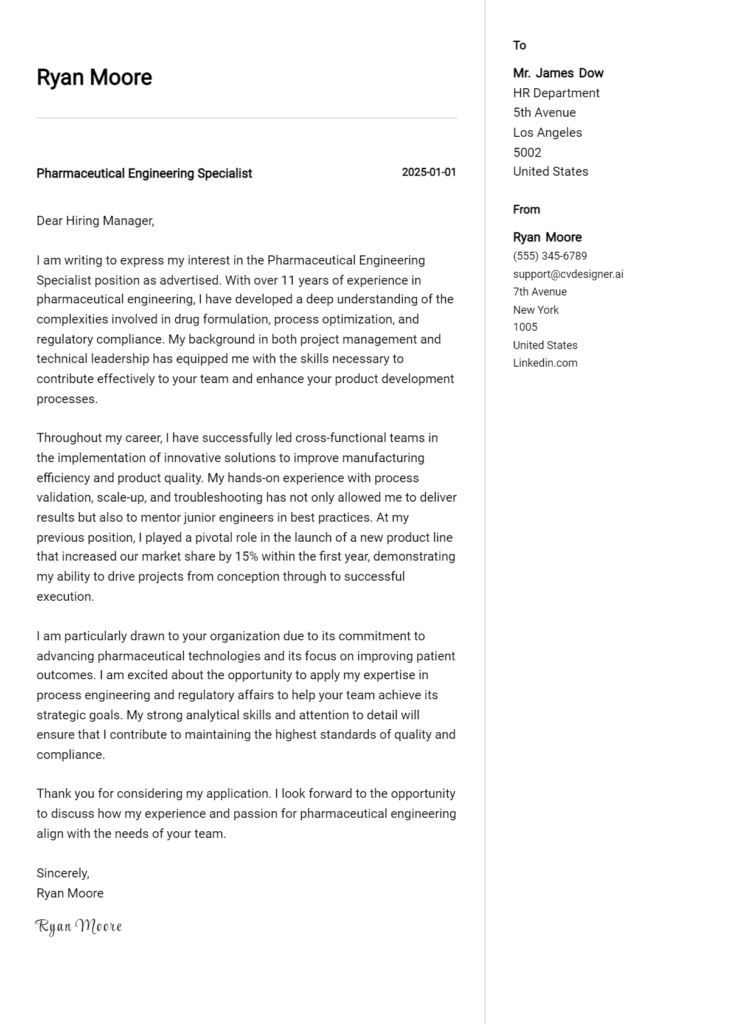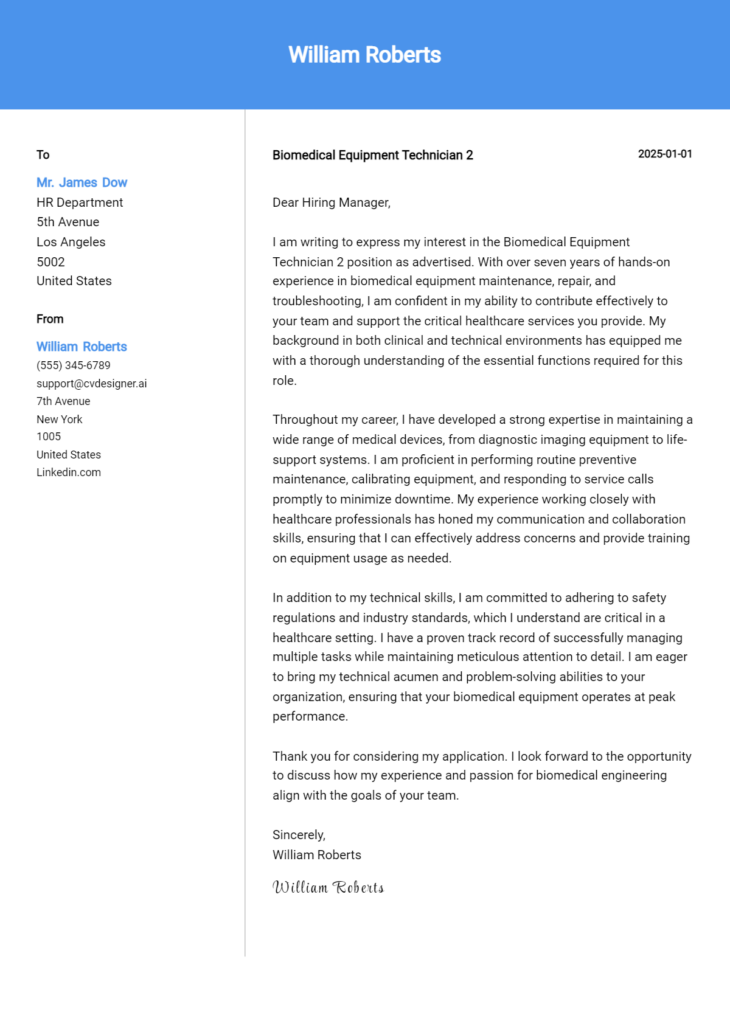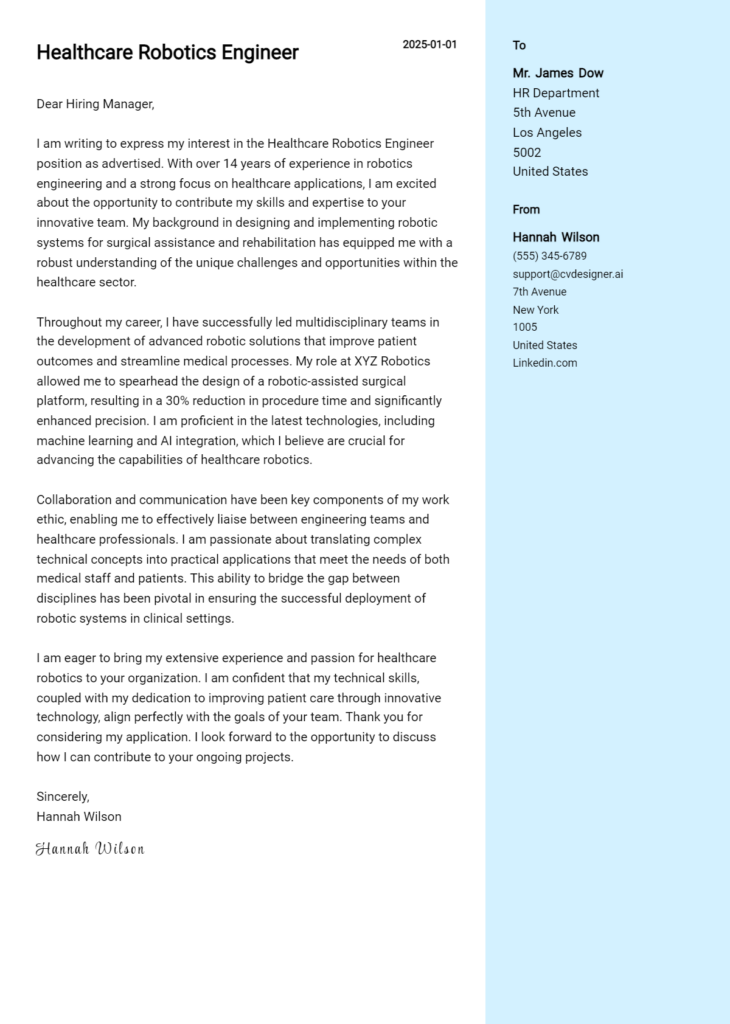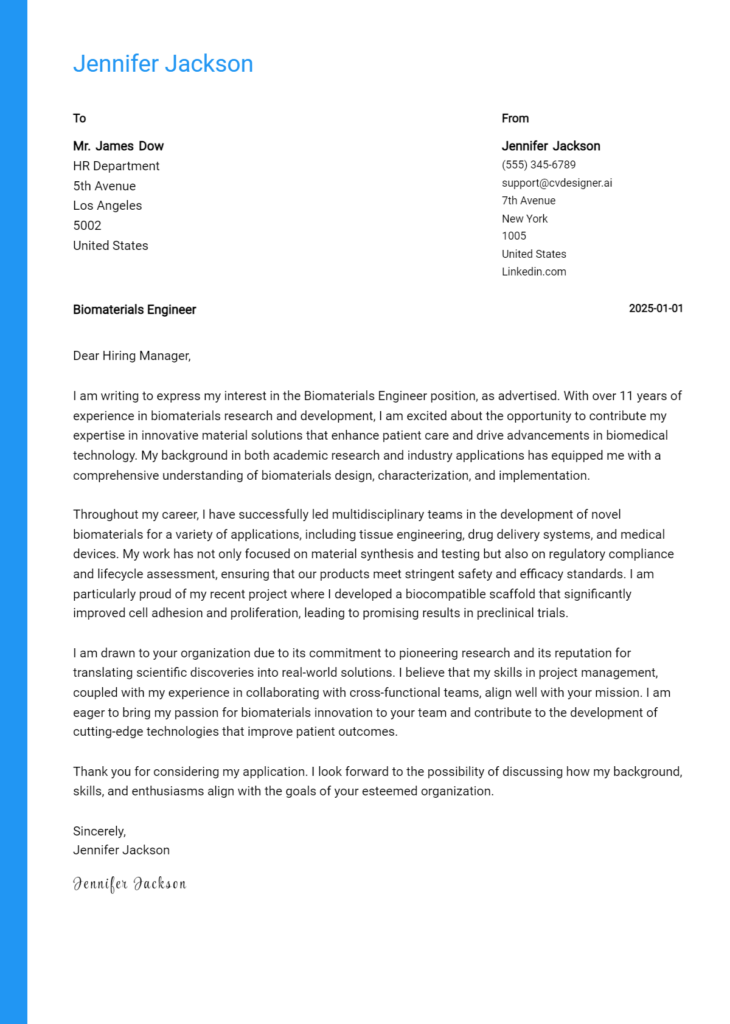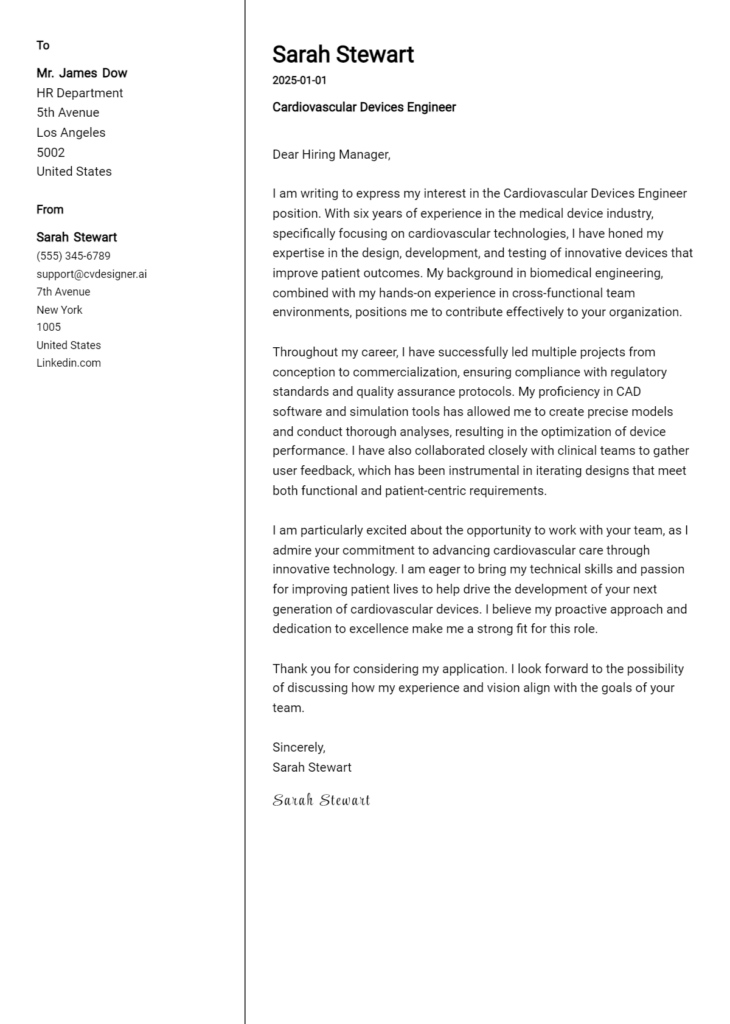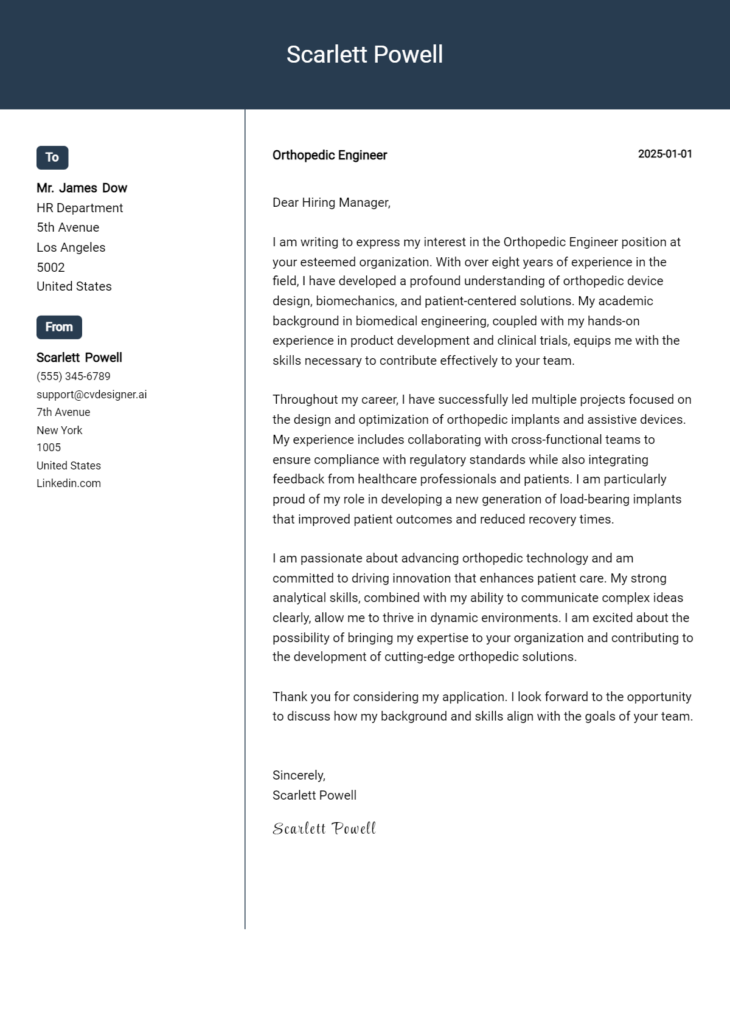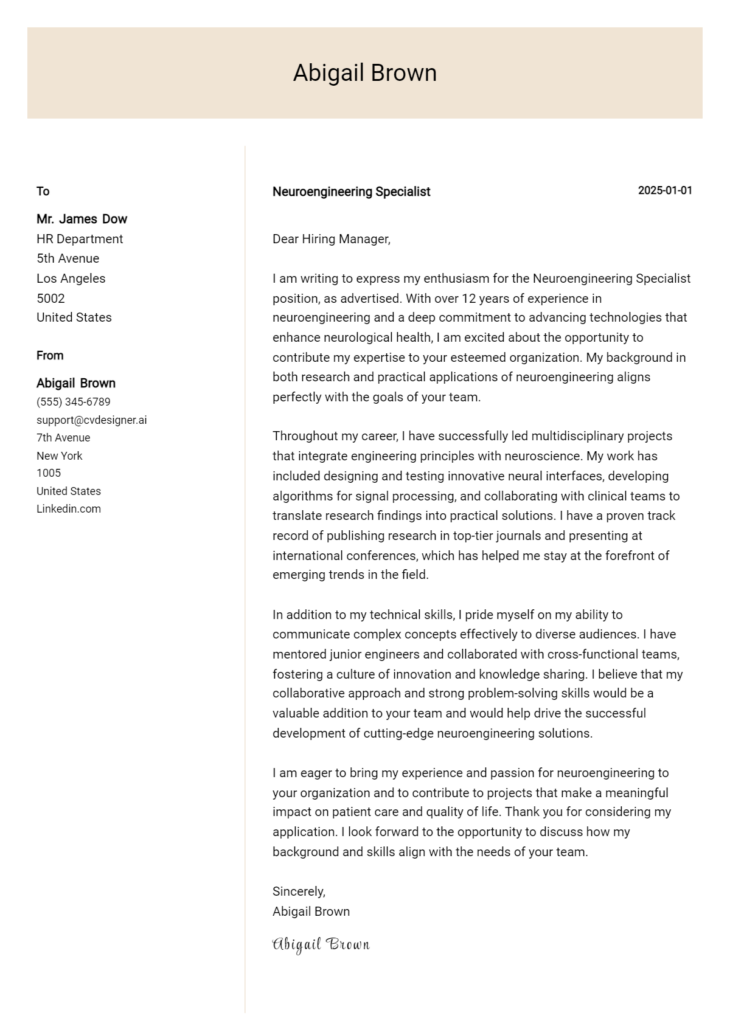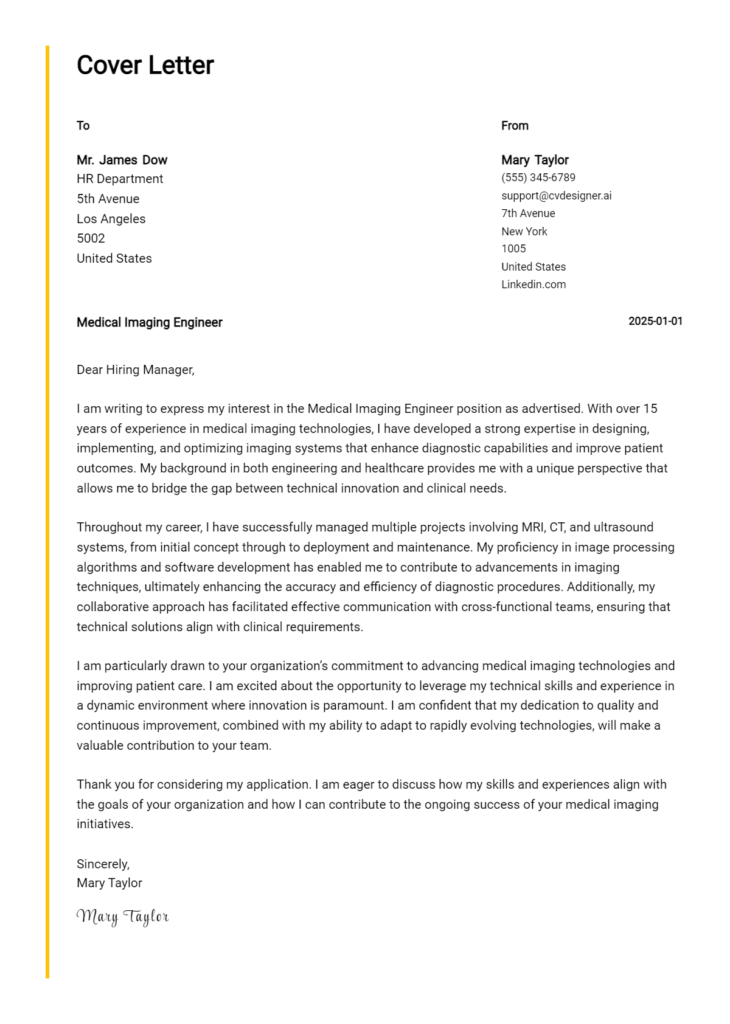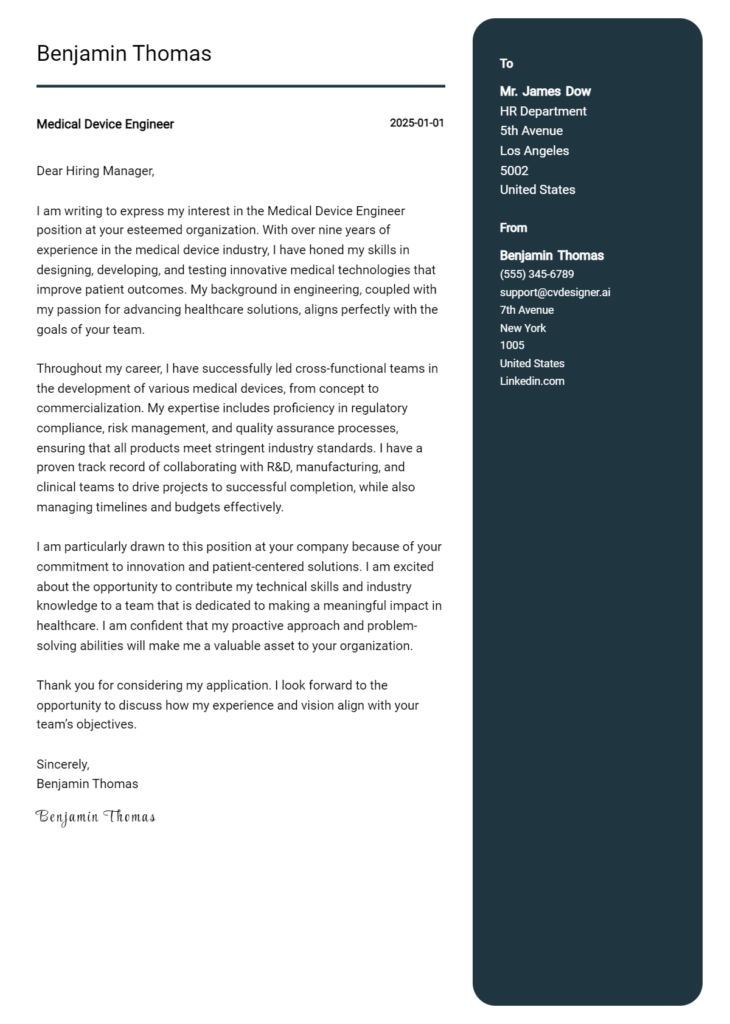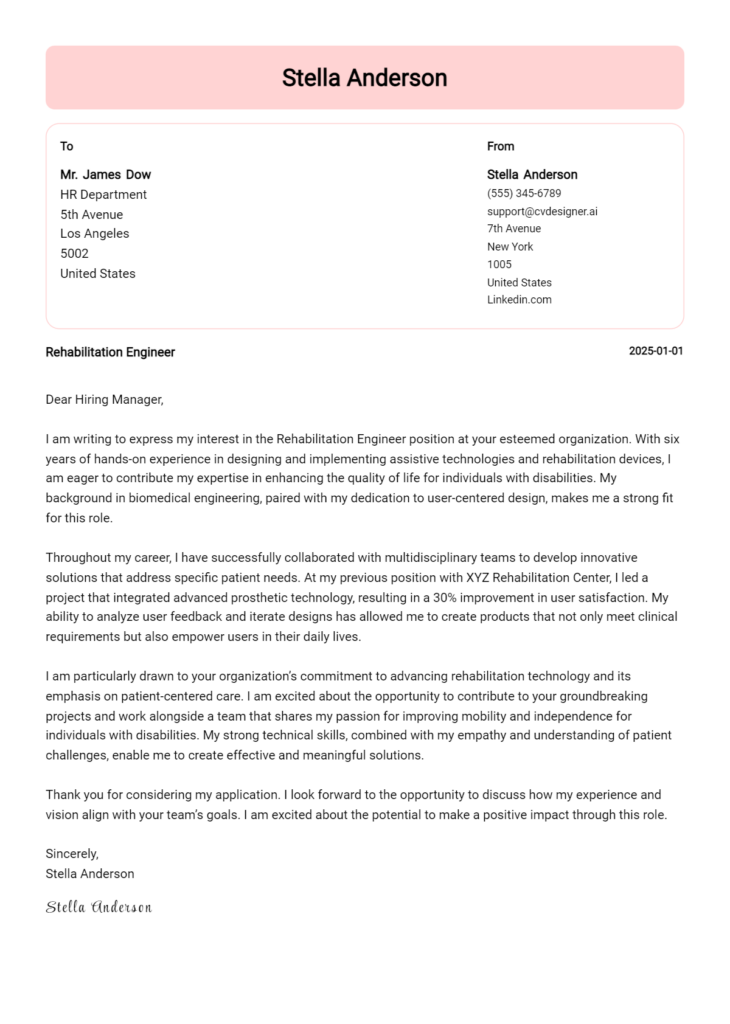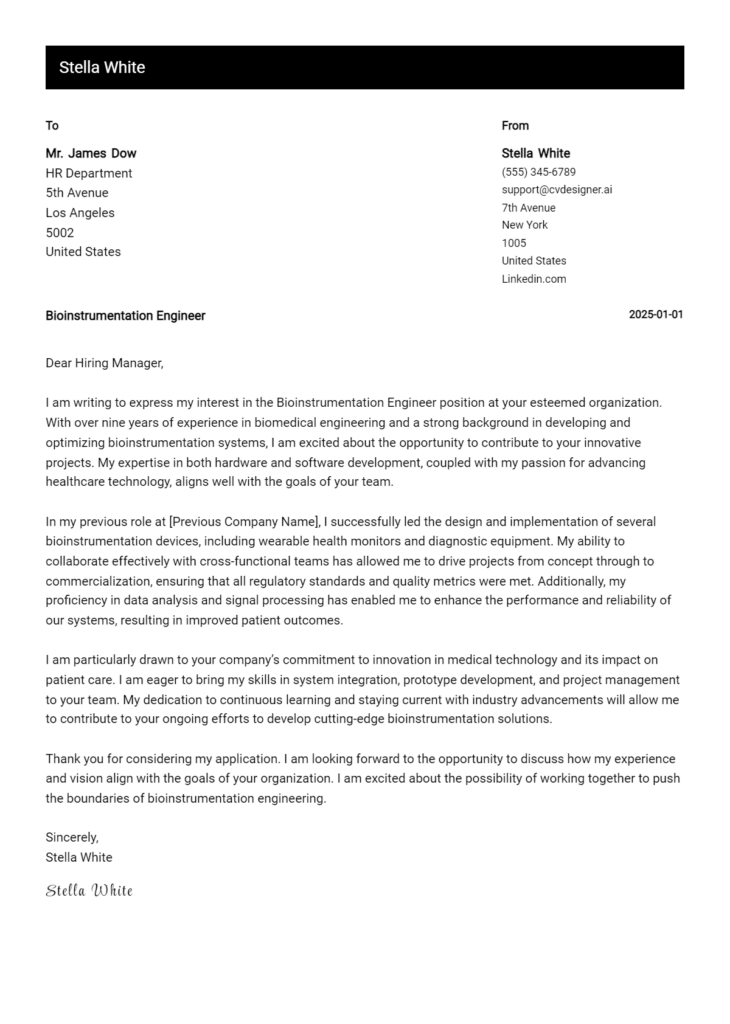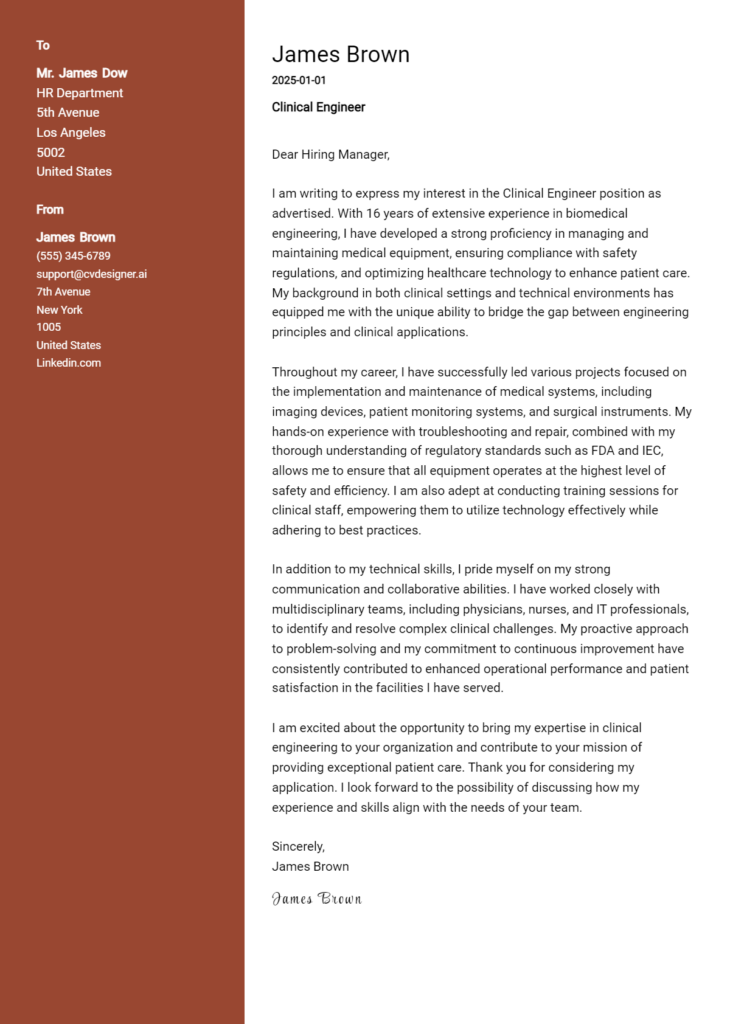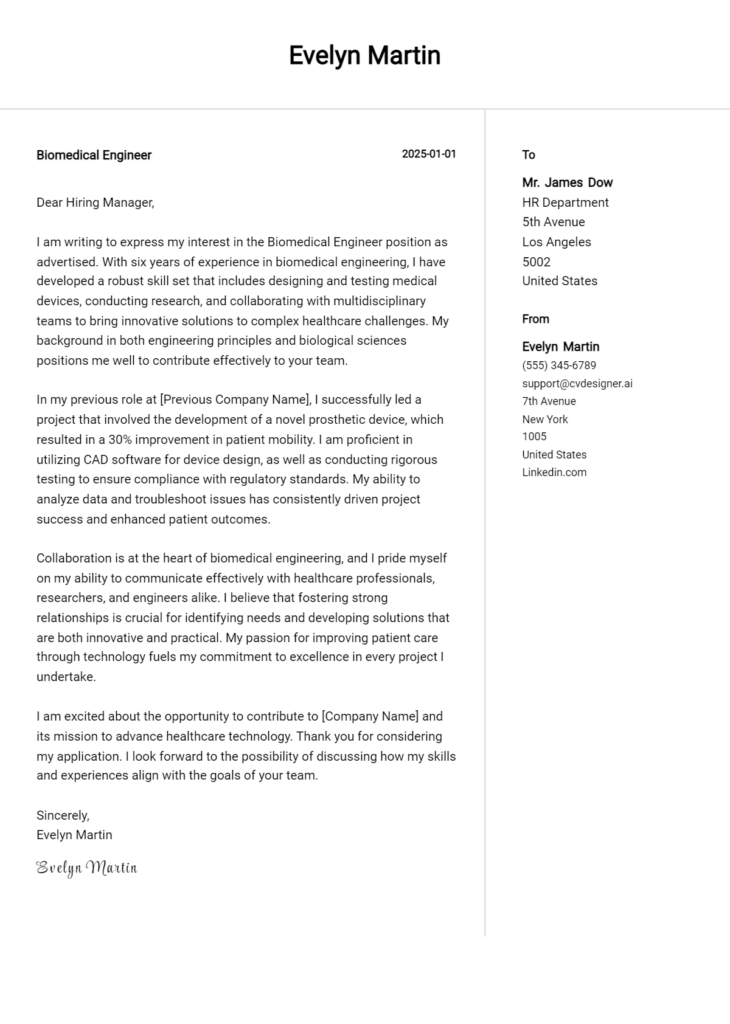Biomedical Equipment Technician 3 Cover Letter Examples
Explore additional Biomedical Equipment Technician 3 cover letter samples and guides and see what works for your level of experience or role.
How to Format a Biomedical Equipment Technician Cover Letter?
Crafting a well-structured cover letter is essential for a Biomedical Equipment Technician as it not only showcases your technical expertise but also reflects your problem-solving abilities and attention to detail—traits that are critical in the medical field. The formatting of your cover letter can significantly influence the hiring manager's first impression, demonstrating your professionalism and commitment to precision in maintaining and repairing medical equipment.
In this guide, we will explore how to effectively structure your cover letter, providing insights and examples tailored specifically for Biomedical Equipment Technicians.
We'll focus on the essential components of a professional cover letter, including:
- Cover Letter Header
- Cover Letter Greeting
- Cover Letter Introduction
- Cover Letter Body
- Cover Letter Closing
Each section is crucial in highlighting your qualifications and ensuring that your application stands out. Let’s break down each part and explain how to make your cover letter shine in this competitive field.
Importance of the Cover Letter Header for a Biomedical Equipment Technician
The cover letter header is a critical element of your application as a Biomedical Equipment Technician. It sets the tone for your professionalism, provides essential contact information, and ensures that your letter reaches the right person. A well-organized header typically includes your name, address, phone number, email, the date, and the recipient's details (name, title, company, and address). Clarity and professionalism in this section not only reflect your attention to detail but also make it easier for potential employers to contact you.
A strong header conveys confidence and competence, while a weak header may lead to confusion or an unprofessional impression. Below are examples of strong and weak cover letter headers to illustrate the difference.
Strong Example:
John Doe 123 Medical Lane Healthcare City, ST 12345 (555) 123-4567 johndoe@email.com October 1, 2023 Jane Smith Hiring Manager ABC Medical Equipment Services 456 Health Ave Healthcare City, ST 67890
Weak Example:
JD 123 Main St 10/1/23 To Whom It May Concern,
The Importance of the Cover Letter Greeting
The greeting of a cover letter is a crucial element that sets the tone for the entire document. It serves as the first point of contact between you and the hiring manager, demonstrating your professionalism and your attention to detail. By directly addressing the hiring manager, you create a sense of personalization that can make your application stand out from others. To achieve this, it's essential to avoid generic greetings such as "To Whom It May Concern" and instead, take the time to research the recipient's name whenever possible. This small effort shows your commitment and interest in the position and the organization.
Here are some examples to illustrate the difference between a strong and a weak greeting for a Biomedical Equipment Technician cover letter:
Strong Greeting Example
Dear Ms. Johnson,
Weak Greeting Example
To Whom It May Concern,
The Importance of a Captivating Cover Letter Introduction for a Biomedical Equipment Technician
A well-crafted cover letter introduction is crucial for a Biomedical Equipment Technician as it sets the tone for the entire application. This initial paragraph should capture the hiring manager's attention immediately, conveying genuine interest in the role while succinctly highlighting key skills or relevant achievements. A strong introduction not only showcases the candidate’s qualifications but also demonstrates their enthusiasm for contributing to the healthcare team. In contrast, a weak introduction can fail to engage the reader, potentially diminishing the candidate's chances of making a positive impression. Below are examples of both strong and weak cover letter introductions for the role of a Biomedical Equipment Technician.
Strong Example:
Dear [Hiring Manager's Name], I am excited to apply for the Biomedical Equipment Technician position at [Company Name], where my extensive experience in medical device maintenance and a proven track record in troubleshooting complex systems align perfectly with your needs. With over five years of hands-on experience in ensuring the reliability and safety of critical healthcare equipment, I am eager to contribute to your team and enhance patient care through my technical skills and dedication to excellence.
Weak Example:
To Whom It May Concern, I am writing to apply for the Biomedical Equipment Technician job. I have some experience with medical equipment and think I could do the job well. I have worked in a hospital setting before, and I am looking for a new opportunity.
Purpose of the Cover Letter Body for a Biomedical Equipment Technician
The cover letter body serves as a critical component of the application process for a Biomedical Equipment Technician, allowing candidates to effectively convey their relevant skills, experiences, and overall value to a prospective employer. This section should highlight specific projects or accomplishments that demonstrate the technician's technical expertise and problem-solving abilities in maintaining, repairing, and calibrating medical equipment. By detailing their contributions to previous roles, candidates can illustrate their impact on patient care and operational efficiency, thus making a compelling case for their candidacy.
Strong Example
Dear Hiring Manager, I am excited to apply for the Biomedical Equipment Technician position at XYZ Hospital. In my previous role at ABC Medical Center, I successfully led a project to overhaul the hospital's defibrillator maintenance program, which resulted in a 30% reduction in equipment downtime and significantly improved response times in emergency situations. My expertise in troubleshooting complex medical devices, coupled with my commitment to ensuring compliance with safety regulations, has equipped me to enhance patient care through reliable and efficient equipment management. I am eager to bring my skills and passion for biomedical technology to your esteemed team. Sincerely, John Doe
Weak Example
Dear Hiring Manager, I am writing to apply for the Biomedical Equipment Technician position. I have experience working with medical equipment and have done some repairs. I think I would be a good fit for your company. I am hardworking and willing to learn more about the job. Best, Jane Smith
Importance of Cover Letter Closing for a Biomedical Equipment Technician
The closing paragraph of a cover letter is crucial as it serves to summarize your qualifications, reiterate your enthusiasm for the position, and encourage the hiring manager to take the next steps, such as reviewing your resume or scheduling an interview. A strong closing can leave a lasting impression and convey your professionalism and eagerness for the role. On the other hand, a weak closing may fail to inspire action or may come off as unenthusiastic.
Strong Example
Thank you for considering my application for the Biomedical Equipment Technician position at [Company Name]. With my extensive experience in maintaining and repairing medical equipment, combined with my commitment to ensuring patient safety and equipment reliability, I am eager to contribute to your team. I would love the opportunity to discuss my qualifications further and explore how I can support your organization's mission. I look forward to the possibility of scheduling an interview and sharing how I can be an asset to [Company Name].
Weak Example
Thanks for reading my letter. I hope you look at my resume. I guess I would like to work for your company if you think I am qualified. Let me know if you want to talk.
These tips will help candidates craft an effective cover letter for a Biomedical Equipment Technician position. A well-written cover letter is essential for standing out in a competitive job market, and it should clearly demonstrate your technical skills, problem-solving abilities, knowledge of the software development life cycle (SDLC), teamwork experience, and passion for continuous learning in the field of biomedical equipment. Here are some detailed tips to help you create a compelling cover letter:
Tips for Writing a Biomedical Equipment Technician Cover Letter
Highlight Your Technical Skills
Clearly outline your technical expertise in biomedical equipment maintenance and repair. Specify the types of equipment you have worked with, such as imaging devices, surgical instruments, or laboratory equipment. This not only demonstrates your qualifications but also shows that you are familiar with the tools of the trade.Showcase Problem-Solving Abilities
Employers value technicians who can troubleshoot and resolve issues efficiently. Include specific examples of challenges you faced in previous roles and the solutions you implemented. This will illustrate your critical thinking skills and your ability to work under pressure.Demonstrate Knowledge of SDLC
If applicable, mention your understanding of the software development life cycle (SDLC), particularly in relation to medical devices. Highlight any experience you have with software updates, validation processes, or collaborating with engineering teams to improve equipment functionality.Emphasize Teamwork and Collaboration
Biomedical equipment technicians often work alongside other healthcare professionals. Share experiences where you collaborated with doctors, nurses, or other technicians to ensure optimal equipment performance. This shows your ability to work well in a team setting and your commitment to patient care.Express a Passion for Continuous Learning
The biomedical field is constantly evolving, so it’s crucial to convey your desire to stay updated with the latest technologies and practices. Mention any relevant certifications, workshops, or training programs you have completed or are looking to pursue. This demonstrates your commitment to professional development and your proactive attitude toward learning.
For additional resources, consider exploring cover letter templates to guide your writing process or use a cover letter builder to create a polished and professional letter that showcases your unique qualifications.
Common Mistakes to Avoid in a Biomedical Equipment Technician Cover Letter
Crafting an effective cover letter is vital for securing a position as a Biomedical Equipment Technician. Common mistakes can undermine your chances of making a strong impression. Here are several pitfalls to avoid:
- Generic Content: Many candidates use a one-size-fits-all approach. Tailor your letter to the specific job and organization to show genuine interest.
- Neglecting Formatting: A cluttered or unprofessional layout can detract from your message. Adhere to a clear cover letter format to ensure readability and professionalism.
- Overemphasis on Responsibilities: Instead of listing past job duties, focus on specific achievements and how they relate to the new position. Use quantifiable results to illustrate your impact.
- Ignoring Keywords: Failing to incorporate relevant keywords from the job description can make your letter less effective. Use industry-specific terms that reflect your technical skills and understanding.
- Too Lengthy or Too Brief: An excessively long cover letter can lose the reader's attention, while a very short one may seem lacking. Aim for a concise letter that effectively conveys your qualifications without being verbose.
- Grammatical Errors: Typos and grammatical mistakes can create a negative impression. Always proofread your letter or have someone else review it before sending.
- Lack of Enthusiasm: A monotonous tone can make you seem uninterested. Exhibit passion for the role and the field of biomedical engineering to engage the hiring manager.
By avoiding these common mistakes, you can significantly enhance your cover letter and improve your chances of landing an interview. For inspiration, check out some cover letter examples that showcase effective strategies.
Cover Letter FAQs for Biomedical Equipment Technician
What should I include in my cover letter for a Biomedical Equipment Technician position?
In your cover letter, you should include a brief introduction that states the position you’re applying for and where you found the job listing. Highlight your relevant education, such as a degree in biomedical engineering or a related field, and any certifications like CBET (Certified Biomedical Equipment Technician). Discuss your hands-on experience with medical equipment, including specific types you've worked with and any roles you've had in troubleshooting or maintenance. Additionally, mention soft skills like communication and teamwork, which are vital in a healthcare setting. Conclude with a strong closing statement expressing your enthusiasm for the role and willingness to contribute to the organization.
How can I tailor my cover letter to a specific employer?
To tailor your cover letter, start by researching the employer's mission, values, and specific technologies they use. Mention any relevant projects or experiences that align with the company’s focus. If the job description highlights specific skills or technologies, ensure you address these directly in your letter. Use the employer's language and terminology to demonstrate that you understand their work environment. For example, if they emphasize innovation in medical devices, discuss any experience you have with cutting-edge equipment or technologies. Personalizing your cover letter shows genuine interest and can set you apart from other candidates.
Should I mention my technical skills in my cover letter?
Absolutely! As a Biomedical Equipment Technician, your technical skills are crucial. Be sure to highlight relevant skills like equipment calibration, maintenance, repair, and software proficiency. Mention specific medical devices you've worked on, such as imaging machines, patient monitors, or infusion pumps. If you have experience with regulatory compliance, such as FDA regulations or ISO standards, include that as well. Providing examples of how you have applied these skills in previous roles can further strengthen your case. This will help potential employers understand your technical capabilities and how they align with the job requirements.
How long should my cover letter be?
Your cover letter should ideally be one page long, consisting of three to four paragraphs. Start with a brief introduction, followed by a paragraph detailing your relevant experience and qualifications. A third paragraph can focus on your technical skills and any specific achievements or projects. Finally, include a closing paragraph that reiterates your interest in the position and invites the employer to contact you for an interview. Keeping your cover letter concise ensures that hiring managers can quickly grasp your qualifications, making it easier for them to consider you for the role.
Build your Cover Letter in minutes
Use an AI-powered cover letter builder and have your letter done in 5 minutes. Just select your template and our software will guide you through the process.

